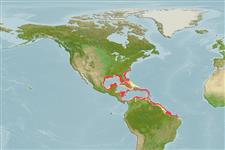Common names from other countries
Environment: milieu / climate zone / depth range / distribution range
Ecologia
; intervalo de profundidade 0 - 141 m (Ref. 109264). Tropical; 35°N - 4°S, 94°E - 38°E (Ref. 83435)
Western Atlantic.
Length at first maturity / Tamanho / Peso / Idade
Maturity: Lm ? range ? - ? cm Max length : 5.0 cm DL macho/indeterminado; (Ref. 83435); common length : 3.8 cm TL macho/indeterminado; (Ref. 355)
Shell turbinate. Sculpture of spiral rows of beads, sometimes with small spines on whorl shoulders. Colour: tan to light brown, with patches of brown, reddish brown, and cream.
On sand and shell and coral rubble, in shallow subtidal (Ref. 355). Found in seagrass, ascidian, and algae habitats (Ref. 83934). Also known from seamounts and knolls (Ref. 3477).
Life cycle and mating behavior
Maturidade | Reprodução | Desova | Ovos | Fecundidade | Larvas
Members of the order Patellogastropoda are mostly gonochoric and broadcast spawners. Life cycle: Embryos develop into planktonic trocophore larvae and later into juvenile veligers before becoming fully grown adults.
Leal, J.H. 2003. (Ref. 355)
Status na Lista Vermelha da IUCN (Ref. 130435)
Status no CITES (Ref. 108899)
Not Evaluated
Not Evaluated
Uso pelos humanos
Pescarias: espécies comerciais
| FishSource |
Ferramentas
Mais informação
Idade/TamanhoCrescimentoComprimento-pesoComprimento-comprimentoMorfologiaLarvasAbundância
Fontes da internet
Estimates based on models
Preferred temperature
(Ref.
115969): 23.5 - 28, mean 26.2 (based on 294 cells).
